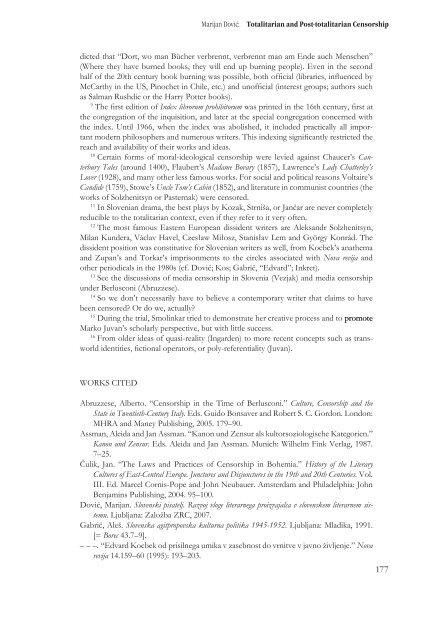Literatura in cenzura - Društvo za primerjalno književnost - ZRC SAZU
Literatura in cenzura - Društvo za primerjalno književnost - ZRC SAZU
Literatura in cenzura - Društvo za primerjalno književnost - ZRC SAZU
- No tags were found...
Create successful ePaper yourself
Turn your PDF publications into a flip-book with our unique Google optimized e-Paper software.
Marijan Dović:Totalitarian and Post-totalitarian Censorshipdicted that “Dort, wo man Bücher verbrennt, verbrennt man am Ende auch Menschen”(Where they have burned books, they will end up burn<strong>in</strong>g people). Even <strong>in</strong> the secondhalf of the 20th century book burn<strong>in</strong>g was possible, both official (libraries, <strong>in</strong>fluenced byMcCarthy <strong>in</strong> the US, P<strong>in</strong>ochet <strong>in</strong> Chile, etc.) and unofficial (<strong>in</strong>terest groups; authors suchas Salman Rushdie or the Harry Potter books).9The first edition of Index librorum prohibitorum was pr<strong>in</strong>ted <strong>in</strong> the 16th century, first atthe congregation of the <strong>in</strong>quisition, and later at the special congregation concerned withthe <strong>in</strong>dex. Until 1966, when the <strong>in</strong>dex was abolished, it <strong>in</strong>cluded practically all importantmodern philosophers and numerous writers. This <strong>in</strong>dex<strong>in</strong>g significantly restricted thereach and availability of their works and ideas.10Certa<strong>in</strong> forms of moral-ideological censorship were levied aga<strong>in</strong>st Chaucer’s CanterburyTales (around 1400), Flaubert’s Madame Bovary (1857), Lawrence’s Lady Chatterley’sLover (1928), and many other less famous works. For social and political reasons Voltaire’sCandide (1759), Stowe’s Uncle Tom’s Cab<strong>in</strong> (1852), and literature <strong>in</strong> communist countries (theworks of Solzhenitsyn or Pasternak) were censored.11In Slovenian drama, the best plays by Ko<strong>za</strong>k, Strniša, or Jančar are never completelyreducible to the totalitarian context, even if they refer to it very often.12The most famous Eastern European dissident writers are Aleksandr Solzhenitsyn,Milan Kundera, Václav Havel, Czesław Miłosz, Stanisłav Lem and György Konrád. Thedissident position was constitutive for Slovenian writers as well, from Kocbek’s anathemaand Zupan’s and Torkar’s imprisonments to the circles associated with Nova revija andother periodicals <strong>in</strong> the 1980s (cf. Dović; Kos; Gabrič, “Edvard”; Inkret).13See the discussions of media censorship <strong>in</strong> Slovenia (Vezjak) and media censorshipunder Berlusconi (Abruzzese).14So we don’t necessarily have to believe a contemporary writer that claims to havebeen censored? Or do we, actually?15Dur<strong>in</strong>g the trial, Smol<strong>in</strong>kar tried to demonstrate her creative process and to promoteMarko Juvan’s scholarly perspective, but with little success.16From older ideas of quasi-reality (Ingarden) to more recent concepts such as transworldidentities, fictional operators, or poly-referentiality (Juvan).WORKS CITEDAbruzzese, Alberto. “Censorship <strong>in</strong> the Time of Berlusconi.” Culture, Censorship and theState <strong>in</strong> Twentieth-Century Italy. Eds. Guido Bonsaver and Robert S. C. Gordon. London:MHRA and Maney Publish<strong>in</strong>g, 2005. 179–90.Assman, Aleida and Jan Assman. “Kanon und Zensur als kultorsoziologische Kategorien.”Kanon und Zensur. Eds. Aleida and Jan Assman. Munich: Wilhelm F<strong>in</strong>k Verlag, 1987.7–25.Čulik, Jan. “The Laws and Practices of Censorship <strong>in</strong> Bohemia.” History of the LiteraryCultures of East-Central Europe. Junctures and Disjunctures <strong>in</strong> the 19th and 20th Centuries. Vol.III. Ed. Marcel Cornis-Pope and John Neubauer. Amsterdam and Philadelphia: JohnBenjam<strong>in</strong>s Publish<strong>in</strong>g, 2004. 95–100.Dović, Marijan. Slovenski pisatelj. Razvoj vloge literarnega proizvajalca v slovenskem literarnem sistemu.Ljubljana: Založba <strong>ZRC</strong>, 2007.Gabrič, Aleš. Slovenska agitpropovska kulturna politika 1945-1952. Ljubljana: Mladika, 1991.[= Borec 43.7–9].– – –. “Edvard Kocbek od prisilnega umika v <strong>za</strong>sebnost do vrnitve v javno življenje.” Novarevija 14.159–60 (1995): 193–203.177
















